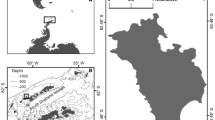Abstract
The diets and trophic interactions among Weddell, crabeater, Ross, and leopard seals in the eastern Ross Sea, Antarctica, were investigated by the use of stable isotope techniques during the 1999–2000 summer seasons. The δ13C and δ15N values in seal serum clearly distinguished the three Antarctic pack-ice seal species at different trophic positions (Weddell>Ross>crabeater). These patterns appeared to reflect a close linkage to their known foraging ecology and diving behaviors, and agreed well with their presumed dietary diversity. The more enriched δ13C and δ15N values in male Weddell seals than those in females suggested differences in foraging preferences between them. Significant differences in δ15N were also found among different age groups of Weddell seals. A strong correlation between the C:N ratios and serum cholesterol was probably due to extremely high cholesterol levels in phocids. Comparisons of isotope data with harbor seals revealed distinct differences between Antarctic phocids and the northern seal species.






Similar content being viewed by others
References
Ackley SF, Bengtson JL, Boveng B, Castellini MA, Daly KL, Jacobs S, Kooyman GL, Laake J, Quetin L, Ross R, Siniff DB, Stewart BS, Stirling I, Torres J, Yochem PK (2003) A top-down, multidisciplinary study of the structure and function of the pack-ice ecosystem in the eastern Ross Sea, Antarctica. Polar Rec 39:219–230
Altabet MA, Francois R (2001) Nitrogen isotope biogeochemistry of the Antarctic polar frontal zone at 170°W. Deep Sea Res 48:4247–4273
Bligh EG, Dyer WJ (1959) A rapid method of total lipid extraction and purification. Can J Biochem Physiol 37:911–917
Burns JM, Trumble SJ, Castellini MA, Testa JW (1998) The diet of Weddell seals in McMurdo Sound, Antarctica as determined from scat collections and stable isotope analysis. Polar Biol 19:272–282
Castellini MA, Davis RW, Kooyman GL (1992) Annual cycles of diving behavior and ecology of the Weddell seal. Bull Scripps Inst Oceanogr 28:1–54
DeNiro MJ, Epstein S (1978) Influence of diet on the distribution of carbon isotopes in animals. Geochim Cosmochim Acta 42:495–506
DeNiro MJ, Epstein S (1981) Influence of diet on the distribution of nitrogen isotopes in animals. Geochim Cosmochim Acta 45:341–351
Fry B, Sherr EB (1984) δ13C measurements as indicators of carbon flow in marine and freshwater ecosystems. Contrib Mar Sci 27:13–47
Green K, Williams R (1986) Observations on food remains in faeces of elephant, leopard and crabeater seals. Polar Biol 6:43–45
Laws EA, Popp BN, Bidigare RR, Kennicutt MC, Macko SA (1995) Dependence of phytoplankton carbon isotopic composition on growth rate and [CO2]aq: theoretical considerations and experimental results. Geochim Cosmochim Acta 59:1131–1138
Laws RM (1984) Seals. In: Laws RM (ed) Antarctic ecology. Academic, London, pp 621–716
Michener RH, Schell DM (1994) Stable isotope ratios as tracers in marine aquatic food webs. Stable isotopes in ecology and environmental science. Blackwell, Oxford, pp 138–157
Minagawa M, Wada E (1984) Stepwise enrichment of δ15N along food chains: further evidence and the relation between δ15N and animal age. Geochim Cosmochim Acta 48:1135–1140
Peterson BJ, Howarth RW, Garritt RH (1985) Multiple stable isotopes used to trace the flow of organic matter in estuarine food webs. Science 227:1361–1363
Popp BN, Laws EA, Bidigare RR, Dore JE, Hanson KL, Wakeham SG (1998) Effect of phytoplankton cell geometry on carbon isotopic fractionation. Geochim Cosmochim Acta 62:69–77
Popp BN, Trull T, Kenig F, Wakeham SG, Rust TM, Tilbrook B, Griffiths FB, Wright SW, Marchant HJ, Bidigare RB, Laws EA (1999) Controls on the carbon isotopic composition of Southern Ocean phytoplankton. Global Biogeochem Cycles13:827–843
Rau GH, Takahashi T, Des Marais DJ (1989) Latitudinal variations in plankton δ13C: implications for CO2 and productivity in past oceans. Nature 341:516–518
Rau GH, Ainley DG, Bengtson JL, Torres JJ, Hopkins TL (1992) 15N/14N and 13C/12C in Weddell Sea birds, seals, and fish: implications for diet and trophic structure. Mar Ecol Prog Ser 84:1–8
Rau GH, Riebesell U, Wolf-Gladrow D (1997) [CO2]aq-dependent photosynthetic δ13C fractionation in the ocean: a model versus measurements. Global Biogeochem Cycles 11:267–278
Schell DM, Barnett BA, Vinette KA (1998) Carbon and nitrogen isotope ratios in zooplankton of the Bering, Chuckchi and Beaufort seas. Mar Ecol Prog Ser 162:11–23
Takai N, Onaka S, Ikeda Y, Yatsu A, Kidokoro H, Sakamoto W (2000) Geographical variations in carbon and nitrogen stable isotopic ratios in squid. J Mar Biol Assoc UK 80:675–684
Tieszen LL, Boutton TW, Tesdahl KG, Slade NA (1983) Fractionation and turnover of stable carbon isotopes in animal tissues: implications for [CO2]aq analysis of diet. Oecologia 57:32–37
Wada E, Terazaki M, Kabaya Y, Nemoto T (1987) 15N and 13C abundances in the Antarctic Ocean with emphasis on the biogeochemical structure of the food web. Deep Sea Res 34:829–841
Acknowledgements
This research was supported by grant OPP 9815176 from the National Science Foundation to M.A. Castellini. Blood samples from Antarctic seal species were collected under MMPA permit no. 495-1524 with University of Alaska Fairbanks Institutional Animal Care and Use Committee (IACUC) approval. Archived harbor-seal blood samples were collected under EVOS project no. 97001. Blood samples from Atlantic harbor seals were collected under permits issued to G.T. Waring (NMFS-NEFSC) and J. Gilbert (The University of Maine, Orono). Cholesterol analysis was conducted by Drs. P.K. Yochem and B.S. Stewart.
Author information
Authors and Affiliations
Corresponding author
Rights and permissions
About this article
Cite this article
Zhao, L., Castellini, M.A., Mau, T.L. et al. Trophic interactions of Antarctic seals as determined by stable isotope signatures. Polar Biol 27, 368–373 (2004). https://doi.org/10.1007/s00300-004-0598-0
Received:
Accepted:
Published:
Issue Date:
DOI: https://doi.org/10.1007/s00300-004-0598-0




